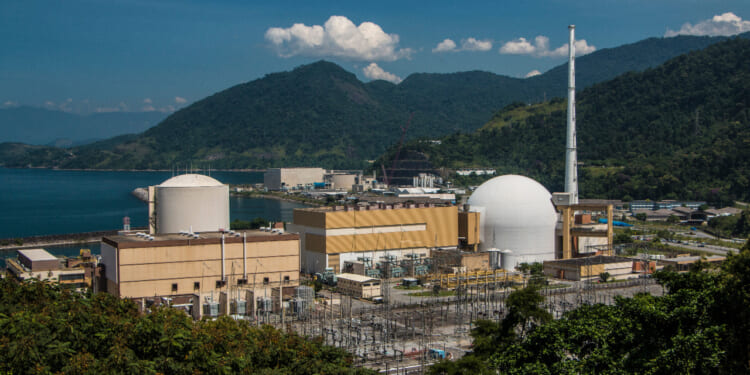Brazil’s efforts to become a clean AI leader will likely force the completion of its nuclear albatross, Angra III, alongside the expansion of alternative renewable energy capabilities.
Brazil promotes its historically diverse energy matrix as a clean solution to artificial intelligence (AI) data centers’ problematic energy footprint. For example, the government launched a $4 billion plan to build data centers dependent on mostly hydroelectric power in 2024. These efforts attracted Amazon and Microsoft to invest over $4 billion USD to expand their data center infrastructure in Brazil. Brazilian entrepreneurs and government officials hope to attract more companies to the data center campus in Rio de Janeiro in coming years.
Policy advocates, including President Lula, hope that transforming Brazil into a potential clean energy powerhouse for energy-consuming AI data centers will distinguish the country and its diverse energy matrix in the global race to lead a new AI-centered global economy. Yet, welcoming AI data centers from the global market will likely also encourage Brazilian officials to complete an expensive and at times politically unpopular nuclear plant, Angra III. Its completion would bring a host of polemic outcomes that might be muted because of the high incentive to develop AI.
More than 30 years since its planned completion, Angra III remains unfinished. The country has two operational nuclear plants (Angra I and II), located 200 km south of the city of Rio de Janeiro. Angra I was built by Westinghouse in the 1970s. Angra II, which was completed in the early 2000s, is the sole product of a landmark bilateral agreement with West Germany in 1975 to build eight nuclear reactors by 1990. President Lula promised to complete construction of the third plant, Angra III, during his first administration (2003 – 2007). But corruption derailed this commitment. As the world’s largest corruption scandal unfolded in the Brazilian petroleum sector in the 2010s, a derivative campaign called Operation Radioactive revealed that officers and state officials also rigged Angra III contracts to win kickbacks from private construction companies. The revelation of financial mismanagement and corruption brought construction to a halt in 2015.
Public opinion and government commitment to Angra III’s completion have since wavered. Cost remains the biggest obstacle. As of 2024, the project has already cost Brazil over a billion dollars (USD). Studies by local organizations estimate that it will cost an additional three billion dollars to complete (USD). Policymakers ostensibly remain committed to Angra III, restating the import of nuclear energy in the recent National Industry Policy in early 2024. The courts also removed construction halts in June 2024 linked to environmental legislation and land concessions to clear the way for project completion. Even still, Angra III is only 65 percent complete. At best, it may come online in 2028 due to existing delays and financing struggles. In response, some activists proposed scrapping the Angra III project and transforming that site into wind and solar farms.
Additionally, growing opponents highlight the environmental costs that come along with expanding nuclear energy. The hazards of mounting nuclear waste storage, the destructive nature of uranium mining, and the increasing risks to oceanside nuclear plants from rising shorelines in a climate-changing world particularly challenge the incorporation of nuclear energy into Brazil’s clean campaign.
Brazilian government entities have been debating whether to complete or abandon Angra III for years because of these issues, but the nuclear site’s salvation has likely arrived in the form of AI.
AI has quickly won both public and private attention for its technological possibilities and its voracious energy demands. Countries are rushing to meet these energy demands, notably with nuclear power. In the United States, AI has very visibly revived nuclear energy interests. For example, in September 2024, Microsoft contracted to reopen the Three Mile Island nuclear reactor that famously melted down in 1979 to power the company’s AI servers. Under the name “the Crane Clean Energy Center,” the plant is expected to reopen in 2028 to provide “safe, reliable, carbon-free electricity” to power the AI revolution. Yet, policymakers have questioned AI’s long-term environmental costs, thus opening the door for Brazil’s savvy clean AI campus campaign.
But can Brazil’s electric grid withstand the additional burden from AI data centers without nuclear energy?
Growing electricity demands in the country have already drawn nuclear energy’s position in the grid into this question, independent of AI’s needs. Critics say yes, the country can meet growing electricity needs without nuclear energy, highlighting the booming wind and solar sectors. In 2024, wind and solar represented 17 percent of the country’s electricity generation. More recently, wind and solar power accounted for over a third of the country’s electrical production in August 2025, while hydropower hit a four-year low. Nuclear supporters disagree, citing the value of nuclear energy as a base load energy source during crises.
Indeed, Brazil’s clean AI campaign may create the very energy problem domestically that it seeks to solve internationally. Officials are trying to position the country’s diversified energy model as an alternative to the nuclear-focused energy options pursued in places like the United States. At present nuclear energy provides a small portion of the country’s overall electricity (around three percent), powering nearly half of the state of Rio de Janeiro’s electricity. Expanding infrastructure to address AI energy demands will force the city and state to increase their dependence on other energy sources, including, potentially, Angra III, amid a domestic energy crisis of their own making.
To be sure, no one is talking about Angra III in this context yet. Despite government policy support for nuclear energy, officials have been silent on Angra III’s place in this plan. Lula’s promotion of green energy hubs has focused on hydroelectricity, solar, and wind power to date. Yet, climate change has already reduced hydroelectricity’s dominance in the country’s electric grid. Supporters have long argued that nuclear energy can reduce pressure on the country’s hydroelectric infrastructure. The outsized demand for energy that data centers create will further strain the hydroelectric-focused grid.
But whether Angra III can supplement energy demands is only part of solving this brewing energy problem. Just as importantly, policymakers should ask whether nuclear energy fits in Brazil’s clean campaign.
Angra III’s construction has stalled repeatedly because of unresolved political, financial, and environmental reasons that simply do not align with the country’s new clean AI campaign. But if history is any indication, Lula is going to reach for Angra III. Lula has been a longtime supporter of the nuclear site. He first revived the project during his first administration in 2007. Despite growing public opposition to the project, Lula is likely to continue this support if it means attracting all the AI investment that comes with it. By incorporating nuclear energy into its plan, the Brazilian AI energy solution may end up mirroring other global markets more than they think.
About the Author: Jennifer Eaglin
Dr. Jennifer Eaglin is an Associate Professor of Environmental History and Sustainability at Ohio State University. Her first book, “Sweet Fuel: A Political and Environmental History of Brazilian Ethanol” (Oxford University Press, 2022) examines Brazil’s sugar-based ethanol industry. Now, her next project focuses on alternative energy policy in Brazil with a focus on nuclear energy. Dr. Eaglin received her Bachelor’s from Spelman College, her Master’s from Johns Hopkins School of Advanced International Studies (SAIS), and her Doctorate from Michigan State University.
Image: Shutterstock/Adriano Aguina


















